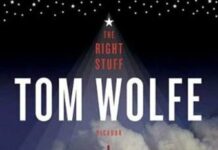
Ebook Info
- Published: 2004
- Number of pages: 370 pages
- Format: PDF
- File Size: 7.30 MB
- Authors: Tom Wolfe
Description
From “America’s nerviest journalist” (Newsweek)–a breath-taking epic, a magnificent adventure story, and an investigation into the true heroism and courage of the first Americans to conquer space. “Tom Wolfe at his very best” (The New York Times Book Review)Millions of words have poured forth about man’s trip to the moon, but until now few people have had a sense of the most engrossing side of the adventure; namely, what went on in the minds of the astronauts themselves – in space, on the moon, and even during certain odysseys on earth. It is this, the inner life of the astronauts, that Tom Wolfe describes with his almost uncanny empathetic powers, that made The Right Stuff a classic.
User’s Reviews
Reviews from Amazon users which were colected at the time this book was published on the website:
⭐I probably should have read The Right Stuff in the 1980s, but it’s still a great read in 2022. Tom Wolfe provides extremely detailed information on the people associated with the beginnings of the American space program.The main focus is on the Mercury astronauts and their families. Wolfe also provides considerable information on test pilots.Some of the details are a bit too personal or a bit too grim, but these attributes simply make The Right Stuff exceptional.
⭐Tom Wolfe’s 1979 book, “The Right Stuff,” chronicles the diverging research of high-altitude rocket planes and spaceflight from the early 1950s through Project Mercury, contrasting the Mercury Seven astronauts with test pilots at Edwards AFB and Naval Air Station Patuxent River, with Chuck Yeager standing out as exemplifying the “right stuff” even though he was not chosen for the space program. Wolfe writes in a somewhat conversational style, working to capture the mentality of test pilots of that era and how it defined what it meant to be a pilot for generations to come, much as Antoine de Saint-Exupéry and others did for pilots of the early twentieth century. Wolfe further evokes the heady emotion of the days of Mercury, when the immediacy of the Cold War turned the Space Race into a battlefront of sorts and the astronauts into Single Combat Warriors to whom the public paid homage. However, Wolfe points out that the test pilots at Edwards were skeptical of the space program, particularly as those running it initially conceived of the pilot as little more than a passenger in a capsule. Meanwhile, the test pilots in the high desert were flying rocket planes to altitudes that required the same skills as a spacecraft, such as control of attitude jets since the air was too thin – or nonexistent – for the plane’s control surfaces to work as the plane had crossed the boundary into space. Despite these achievements, the astronauts captured the public’s imagination and eventually succeeded in using their public positions to regain some of their status as pilots, though the heady days of Mercury did not last into the Gemini and Apollo programs, where spaceflight became more routine as astronauts were longer regaled as Single Combat Warriors.The style and success of Wolfe’s book ensured its adaptation and Hollywood has done so twice, first in Philip Kaufman’s 1983 film and again in the 2020 television series from National Geographic. This Vintage Classics copy is a nice paperback edition with a great pop-art cover and an introduction from Astronaut Scott Kelly that helps to capture of the legacy of “The Right Stuff.” Something appears to have gone wrong during the formatting process, however, as there are several typographical errors throughout the book (extraneous letters jumbled in the middle of words, words divided by a hyphen as if they were meant to be split between two lines, and multiple instances of the number 1 in place of an “l” or an “I”). These occur often enough to be noticeable, but thankfully Wolfe’s narrative is engrossing and makes up for it.
⭐I got that eerie familiar feeling about this book early on but it wasn’t until the chapter on Chuck Yeager that I was sure that I had read it before.
⭐This book is about the Mercury Project, NASA’s first manned space missions, and the origins of the astronaut program.Tom Wolfe was a practitioner of “New Journalism.” The only previous experience that I had with that style was with Hunter S. Thompson’s alcohol-and-other-drugs-fueled escapades in Las Vegas while covering a race for Sports Illustrated and his alcohol-fueled experiences at the Kentucky Derby. Based on those reading experiences, it was my understanding that one of the hallmarks of New Journalism was Journalist-as-Participant. The historical record, however, is pretty clear that a drunk Tom Wolfe had not, in fact, been blasted into orbit with John Glenn or any of the other Mercury 7 astronauts. How then is The Right Stuff an example New Journalism?Well, Tom Wolfe wrote his butt off. The book reads more “literary” than as an object of traditional journalism. Let me explain…no, there is too much…let me sum up…A traditional journalistic or scholarly book about the early astronauts and “what made them tick” might include quotations from interviews with those astronauts and people that knew them, government officials and news reporters from the time, and maybe a few academics to provide some Authoritative Interpretation. The writer wouldn’t put forth a theory of their own about the astronaut motivations, or, if they did, there’d be a ton of explicit sources backing them up.Tom Wolfe just puts his theories out there, front and center, and then writes with such force – with repeated interjections, sometimes with exclamations! – and capitalizations and callbacks and pretty descriptions and literary techniques that the reader will forget that they are reading some nonfiction book; this story may be (at least in some sense) true, but it reads like a novel. It never really dives into the minutiae of bureaucratic organization nor is it really interested in any one’s point of view other than that which drives the author’s central point: the astronauts were military test pilots fueled by a Manly Competitive Desire to BE THE BEST and that performing well under pressure in that competition exhibits The Right Stuff (which is never explicitly defined, although I have my own theories).I am a fan of David Foster Wallace’s writing, and I could see a clear influence from Tom Wolfe’s style in Wallace’s writing. And David Foster Wallace was certainly not the only literary writer influenced by Wolfe. Fans of literature really should check this out, just to trace back certain styles to their creator (or popularizer). Science fiction fans could be inspired by a (more or less) true account of fighter pilot personality and how their influence (or lack thereof) could impact a fictional space program. Fans of nonfiction could see that there are ways of telling a nonfiction story rather than the usual, traditional methodologies. I’d recommend this book to anyone, just with the disclaimer that it is NOT like the usual biographical or documentary-style rendition of the Mercury Project. The writer’s style is definitely noticeable, and some might be distracted by it (or it could just not be to their taste).
⭐I bought “The Right Stuff” after reading about the enthusiasm for it by astronaut Scott Kelly. I was expecting great things.I was very disappointed. Yes, there was some “stuff” about astronauts but a great deal about their wives: I found that utterly tedious and to a large extent irrelevant. The ticker-tape (and similar) events were described ad nauseam. Yawn.My criterion for giving a book the thumbs up – and I get many books on Kindle – is will I read it again? I have to say that “The Right Stuff” is already in the Kindle “bin” and won’t see daylight again.
⭐In some respects i wish I had read this before I had read first man by James Hansen. This is an account of America’s first foray into the space race with Russia. I have to be honest, the blend of fact and fiction took me a while to get into but once I got used to that (maybe a quarter of the way through) it became both fascinating and exciting. Wolfe is able to, using this extraordinary blend of fact and fiction, to tell this story from so many angles, whether it be the astronauts, their wives, the hierarchy within NASA, politicians, the American people and the world no less. Wolfe uses techniques such as short, sharp sentences and a lot of examination marks! But for me, that worked. It took me a while to get into this but once I did, it was a cracker. Highly recommended
⭐My favourite book now on kindle, and about flipping time!This kindle edition is my 3rd I’ve bought as I’ve read and re-read the first two in paperback so often they’ve eventually fallen apart. Ths edition has a foreword by astronaut Scott Kelly.This is the book that started my obsession with collecting books on the history of space exploration. I’m now eagerly awaiting the audio version…
⭐When asked how he had survived his remarkable career as a test pilot, Capt Brown answered that it was careful preparation: “If you had the attitude: ‘Kick the tyres, light the fires and the last one in the air is a sissy, you wouldn’t last long.” This account of the test pilots leading up to the first American space flights demonstrates very clearly why they had such high casualty rates. Quoting from the book: “it was flying and drinking and drinking and driving.” It is a great portrait of a reckless generation with the exceptions like John Glenn and Neil Armstrong (who became a good friend of Eric Brown) showing that with a different attitude it was possible to live long and prosper – the one as a highly respected US Senator, the other as a Professor of Engineering.
⭐In 2009 a colleague recommended this book, 11 years later I found it on Kindle, thank you Vintage Classics.The narrative draws from a number of definitive sources that [for me] places the reader as a ‘fly on the wall’ with the families and the elite individuals, testing, pushing and articulating aviation’s next steps and space capabilities.The story pursues and tackles the challenges of supersonic flight and escaping the earth’a atmosphere. Incredible.
Keywords
Free Download The Right Stuff 2nd Edition in PDF format
The Right Stuff 2nd Edition PDF Free Download
Download The Right Stuff 2nd Edition 2004 PDF Free
The Right Stuff 2nd Edition 2004 PDF Free Download
Download The Right Stuff 2nd Edition PDF
Free Download Ebook The Right Stuff 2nd Edition

